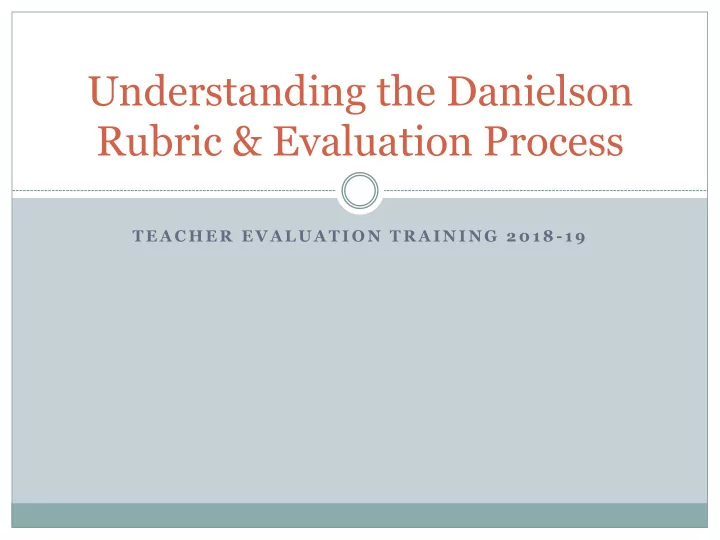

Understanding the Danielson Rubric & Evaluation Process T E A C H E R E V A L U A T I O N T R A I N I N G 2 0 1 8 - 1 9
Thank You! A special thanks to our APPR Committee: Nick Askey, Elementary Teacher Jolene Ayres, HS ELA Teacher Tammy Barber, ES AIS Teacher Dave Doty, HS Science Teacher Dona Fredrickson, HS Special Education Teacher Nancy Schmick, ES AIS Teacher Administrators: Micah Oldham, Jenny Conklin-Frank
Let’s Sort it Out ACTIVITY: 1. In your teams, review the essential elements contained in the envelope provided. 2. Organize these essential elements into team defined categories based on their common traits.
PART 1: UNDERSTANDING DOMAINS & COMPONENTS PURPOSE: 1. Align the essential elements of the teaching and learning. 2. Compare the NYSUT & Danielson Rubrics.
NYSUT vs. Danielson 2013 Rubrics NYSUT Danielson 2013 7 Standards 4 Domains 35 Elements 18 Components 15 observable 10 observable components across components across 3 standards 2 domains 2 standards aligned to 1 domain aligned to pre-conference pre-conference Pre-conference form Lesson plan
Let’s Sort it Out – Take 2 ACTIVITY: 1. Resort your essential elements using the categories (domains) identified in the Danielson Placemat.
PART 2: LESSON PLANNING & DOMAIN 1 PURPOSE: 1. Defining the components of the observation cycle. 2. Becoming familiar with the components of Domain 1. 3. Evaluating the effectiveness of a lesson plan.
Components of Observation ANNOUNCED OBSERVATIONS: 1. Lesson Plan 2. Pre-Conference 3. Observation 4. Post-Conference UNANNOUNCED OBSERVATIONS: 1. Observation 2. Post-Conference
Components of Domain 1 DOMAIN 1: PLANNING & PREPARATION 1a: Knowledge of Content & Pedagogy 1b: Knowledge of Students 1c: Setting Instructional Outcomes 1d: Knowledge of Resources 1e: Designing Coherent Instruction 1f: Designing Student Assessments
Components of Domain 1 ACTIVITY: 1. In your teams, review the lesson plan template provided at your table. 2. Align each part of the lesson plan template with one of the components of Domain 1.
Lesson Plan Learning standards that are explicitly taught, practiced, and/or mastered throughout the lesson. What students will know, understand, and be able to do by the 1c: Setting Instructional Goals end of the lesson; observable and measurable; student-friendly Learning activities support instructional objectives; thoughtfully 1e: Designing Coherent Instruction sequenced; aligned and appropriate based on unit sequence 1d: Knowledge of Resources Relevant and rigorous; encourage hands-on or inquiry-based learning; integrates technology or digital media
1a: Demonstrating Knowledge Based on your expertise with the content and knowledge of your learners, where are they going struggle? of Content & Pedagogy What backgrounds skills and knowledge do kids need in order to be successful with the lesson? Every lesson has a beginning, middle, and an end. What experiences will learners engage in throughout the lesson? Research-based strategies; based on interest and skills; meets the 1b: Knowledge of Students needs of learners; student choice & voice student progress; engages learners in assessment of their progress 1f: Assessing Student Learning Using assessment before, during, and after learning to gauge
PART 3: PERFORMANCE LEVELS & DOMAIN 2 PURPOSE: 1. Recognize the qualifiers used at various levels of practice (developing, effective, etc.) 2. Becoming familiar with the components of Domain 2.
Components of Domain 2 DOMAIN 2: LEARNING ENVIRONMENT 2a: Creating Respect & Rapport 2b: Culture of Learning 2c: Classroom Procedures 2d: Managing Student Behavior 2e: Organizing Physical Space
Words of Effectiveness ACTIVITY: 1. Split your table team into 3 groups. 2. Assign each group one effectiveness category – Developing, Effective, Highly Effective. 3. Record qualifiers for each effectiveness category in the table provided.
PART 4: OBSERVING INSTRUCTION & DOMAIN 3 PURPOSE: 1. Becoming familiar with the components of Domain 3. 2. Observe, collect, sort, and rate evidence of effectiveness.
Components of Domain 3 DOMAIN 3: INSTRUCTION 3a: Communicating with Students 3b: Questioning & Discussion Techniques 3c: Engaging Students 3d: Using Assessment in Instruction 3e: Flexibility & Responsiveness
You Be the Judge! ACTIVITY: 1. Watch the observation lesson video and jot down your observation of both teacher and learner actions. 2. With your table mates, organize your evidence into the components of Domain 3. 3. Using the rubric provided, evaluate the effectiveness of each of components and determine an average score.
You Be the Judge!
PART 4: PROFESSIONAL PRACTICE & DOMAIN 4 PURPOSE: 1. Becoming familiar with the components of Domain 4.
Components of Domain 4 DOMAIN 4: PROFESSIONAL PRACTICE 4a: Reflecting on Teaching 4b: Maintaining Accurate Records
Making Connections ACTIVITY: How do components 4a & 4b connect to the lesson observation?
Any Questions?
Recommend
More recommend